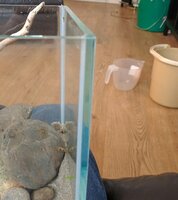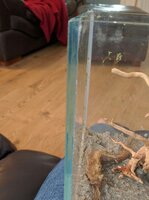Yes you can cut it out with a stanley blade and scrape it clean after the seams are cut out. But the tank needs to be empty and all of it needs to be out, new kit does not attach very good to old cured kit.
Cutting it length ways where the point of the blade touches the glass is where you start, dont cut it where the point of the blade touches the seam between the glass panels. Maybe you need a scrapper to gently help to get the seam out in one pull. Make sure you use a new very sharp blade and scraper. Dull blades don't cut they rip, as soon as you need to apply pressure the blade tip is getting dull, glass is relatively hard and makes stanley blades dull sooner then you think.
After it is cut out, then scrape it clean, check with a strong light and keep scraping till there is no cured piece of silicone left. It needs to meticulously clean, if not the tiniest speck of old silicone will show once it is kit again. Make sure you do not push the blade into the seam between the panels, again a sharp blade will prevent you from applying to much pressure.. A dull blade will make you push in there much easier, the less force you need the beter.
If all is cleaned out perfectly degrease it with alcohol and a lint free cloth. And check again if there is no speck of old silicone left, do not double check but triple check.
🙂
Then apply masking tape in the corner and leave free space in the desired seam thiknes in the corner. Once you worked all around and double checked again if all is straight, check again if all is clean, degrease it again with alcohol.
Now apply the new kit, don't use to much even if you use masking tape. First seam done, spray a little water with dishwashing soap on the silicone multi tool and straighten the seam and push it into the corner.. This tool also scrapes off all excess silicone. Wipe the tool clean.. Go like that all around the tank and when all corners are done pull the masking tape gently and cleanly out. You got one go, that's it.
After that, it is done, all faults are permanent, don't look at it don't tough it for at least 24 hours. If all is as desired after that, you're good to go.. If not wait again for a few days preferably a week, to let it fully cure and start over again. Cleaning out fresh kit within the first days is a job you do not want to start on. It is still much to soft.
This kitting part and removing of masking tape you need to do rather quickly with in the skinning time of the kit. +/- 12 minutes depending on the temperatur. 12 minutes is average at room temp. This is where most people fail and panic in the time pressure, that's the only difficult part of it, keep it cool work steadily and relaxed. Preparing you can work a day on if you like, finnishing it off neatly is 12 minutes tops.

Not using masking tape, needs years of kitting experience and a very steady hand and a very professional kit gun. Obviously your builder laked one of it and not used masking tape.
😉
















